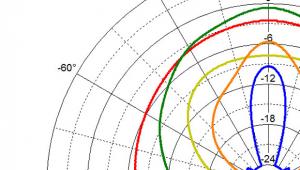Distortion: A Show and Tell Page 3
Following orders
Sometimes added harmonics don't sound so bad. That's why many guitar players intentionally add distortion to their sound. But sometimes these harmonics sound really awful. It depends on the order of the harmonic.
A 2nd-order harmonic is double the original frequency, so for a 440 Hz tone it's 880 Hz. That doesn't necessarily sound all that bad, because it's exactly one octave up and it thickens the sound in a way that can be pleasing. In fact, guitar players such as Wes Montgomery, Pat Metheny and Steve Howe often play in octaves, picking both the fundamental note and the same note one octave up. And if you got a problem with Wes Montgomery's sound, we need to step outside.
While 2nd-order harmonics can be unobjectionable or even kinda nice, 3rd-order harmonics are as unwelcome as bagpipes in a blues band. That's because the extra harmonic isn't in tune with the fundamental tone. Take that same 440 Hz tone, which is an A note. Second-order distortion just adds another A note an octave higher at 880 Hz. But 3rd-order distortion adds a slightly out-of-tune E note at 1,320 Hz, which is a musical interval roughly an octave and a fifth above the fundamental. A fifth is the interval guitar players add to the root note to form a power chord. Thus, too much 3rd-order harmonic distortion suddenly makes Beethoven's "Ode to Joy" sound more like "Smoke on the Water," which I'm confident wasn't what Beethoven intended. (I just said that in the hope it will inspire a nasty e-mail from Ritchie Blackmore. Then I can say I got an e-mail from Ritchie Blackmore.)
This tone I made demonstrates the difference between 2nd- and 3rd-order harmonic distortion. A 400 Hz tone plays for 3 seconds, then it's joined by an 800 Hz tone at -20 dB, simulating 10% 2nd-order distortion. Three seconds later the 800 Hz tone is replaced by a 1,200 Hz tone at -20 dB, simulating 10% 3rd-order distortion. Then you hear 3 more seconds of the original 400 Hz tone.
The 2nd-order harmonic is actually rather pleasant, like a violin playing in unison with a cello. But the 3rd-order harmonic is quite jarring, it's it? Same rules go for higher harmonics, too. The 4th-order harmonic is two octaves above the fundamental, so it sounds not-so-bad. The 5th-order harmonic is two octaves and an out-of-tune third above the fundamental, so it sounds awful. This is why you often hear that odd-order harmonic distortion is more objectionable than even-order harmonic distortion.
While audio experts often disagree about how important harmonic distortion is, how audible it is and how best to measure it, there's no question that it can greatly affect the sound you hear. And as we move to smaller, more portable sound systems with tiny speaker drivers and low-powered internal amplifiers, we're likely to hear a lot more distortion in the future.
- Log in or register to post comments




































































